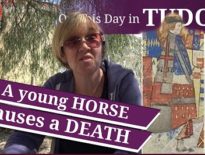On this day in Tudor history, 12th March 1537, Cistercian monk William Haydock of Whalley Abbey, Lancashire, was hanged for treason at Whalley.
Haydock's abbey had been implicated in the 1536 Pilgrimage of Grace Rebellion, so Henry VIII wanted the abbey punished. Find out more about Whalley Abbey's part in the rebellion, how Haydock and several other monks were punished, and what exactly happened to William Haydock's remains, in today's talk.
Also on this day in Tudor history, 12th March 1539, Thomas Boleyn, father of Queen Anne Boleyn died at Hever Castle in Kent. Here's last year’s video so you can find out more about Thomas’s death, resting place, and also what happened to him after the executions of his children, Anne and George, in May 1536:
Also on this day in history:
- 1564 – Baptism of Christopher Bales, Roman Catholic priest and martyr. Bales was executed by hanging on 4th March 1590 in Fleet Street. Two others, Nicholas Horner and Alexander Blake, were executed at Smithfield and Grays Inn Lane for harbouring him.
- 1573 (11th or 12th) – Death of Edmund Brydges, 2nd Baron Chandos, soldier, politician, Lord Lieutenant of Gloucestershire and Vice-Admiral of Gloucestershire. He was laid to rest at Sudeley.
- 1628 – Death of John Bull, composer, musician and organ builder, at Antwerp.
Transcript:
On this day in Tudor history, 12th March 1537, Cistercian monk William Haydock of Whalley Abbey, Lancashire, was hanged for treason at Whalley.
What had Haydock done? Well, he was a senior monk at Whalley Abbey, which had been caught up in the 1536 Pilgrimage of Grace Rebellion, a rebellion of the common people of parts of Northern England against Henry VIII’s new religious policies, the dissolution of the monasteries and the advice the king was receiving from some of his senior advisors.
“A History of the County of Lancaster” explains that “At the end of October, 1536, Nicholas Tempest, one of the Yorkshire leaders of the rising, came to Whalley with 400 men and swore the abbot and his brethren to the cause of the commons.” It goes on to say that John Paslew, abbot of Whalley, was alleged to have lent Tempest a horse and some plate. It is also said that Paslew refused to sign the oath of allegiance and that an unnamed monk at the abbey had declared that no secular knave should be head of the church. After the rebellion had been successfully put down, King Henry VIII wanted the abbey punished.
Whalley monks Haydock, Abbot Paslew and John Eastgate were tried for high treason in March 1537 at the spring Lancashire Assizes, along with Eastgate’s brother, Richard, who had joined the abbey following the dissolution of nearby Sawley Abbey. John Eastgate was acquitted, but Richard Eastgate, the abbot and William Haydock were found guilty. Eastgate and Abbot Paslew were hanged at Lancaster on 10th March and their bodies quartered and displayed in various towns in Lancashire. William Haydock was hanged at Whalleyin a field adjoining his abbey, on 12th March. He wasn’t dismembered like the others, and his nephew, who was also called William Haydock, was able to save Haydock’s body and hide it at the Haydock family home, Cottam Hall. Haydock’s remains were found when part of the hall was demolished in the 19th century.



Leave a Reply